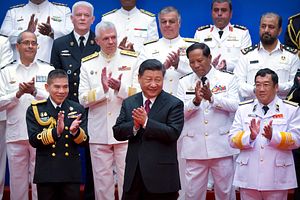Chinese President Xi Jinping urged closer ties among the world’s navies on Tuesday, amid tensions over China’s rapid expansion of its naval forces and forceful assertions of territorial claims in the South China Sea.
Xi’s remarks came in an address to foreign naval officers attending a fleet review marking the 70th anniversary of the People’s Liberation Army Navy, an event Beijing is using to showcase its growing ability to exert force far from its shores.
Following his speech, Xi boarded the destroyer Xining, one of China’s most modern and capable warships, at the northern port of Qingdao to preside at the review, which also is to feature China’s sole commissioned aircraft carrier, numerous other surface ships and submarines and a display of naval aviation.
State broadcaster CCTV showed Xi standing on deck in a heavy coat in thick fog as various ships and submarines sailed by, their officers and crew members wearing formal uniforms and giving salutes.
China’s navy will “continue to strengthen exchanges and cooperation with foreign navies, actively shoulder its international responsibilities, safeguard the security of international waterways and provide more public goods for maritime security,” Xi was quoted as saying by the official Xinhua News Agency.
“Holding high the banner of win-win cooperation, the Chinese military is committed to creating a security environment featuring equality, mutual trust, fairness and justice, joint participation and shared benefits,” said Xi, who also heads China’s armed forces.
Such rhetoric contrasts starkly with China’s aggressive approach to its territorial claims in the South China Sea, where it has built military installations on man-made islands in the crucial waters, which are also claimed by several other nations.
China claims virtually the entire South China Sea, along with rights to its fisheries and seabed resources.
While Beijing says it upholds the rights to free navigation and overflight in the area, its forces have been accused of challenging or operating dangerously around military vessels and aircraft from other countries, including the United States, as well as harassing fishing vessels from the Philippines and others.
The Philippines earlier this month issued a rare public rebuke of large numbers of Chinese vessels near islands and islets occupied by the Philippines in the disputed waters, saying the Chinese presence was illegal.
The Philippine military has monitored more than 200 Chinese vessels from January to March in a disputed area named Sandy Cay near a Philippine-occupied island called Pag-asa by Filipinos.
U.S. freedom of navigation operations in which navy ships sail close to Chinese-held islands have been a particular source of friction, with China dispatching ships and aircraft to protest the foreign presence.
China is building naval vessels at a rate outpacing its rivals, including the U.S., and is also establishing a powerful coast guard to back up its territorial claims. Its first domestically built aircraft carrier is set to enter service — with more believed to be in the works — while its missile destroyers and nuclear attack submarines are equipped with increasingly lethal weaponry.
It has also ventured farther from shore than ever, and undertaken international missions
including sending ships to patrol for pirates in the Gulf of Aden, evacuating civilians from war-torn Yemen and offering medical services in developing nations as far away as South America.
Tuesday’s naval review included 32 Chinese vessels and 39 aircraft, along with 18 vessels from 13 foreign countries friendly to China.
One notable absence was the United States, which did not send a vessel, despite the arrival last week of the 7th Fleet flagship, the USS Blue Ridge, in the semi-autonomous territory of Hong Kong.
Reporting by the Associated Press.

































